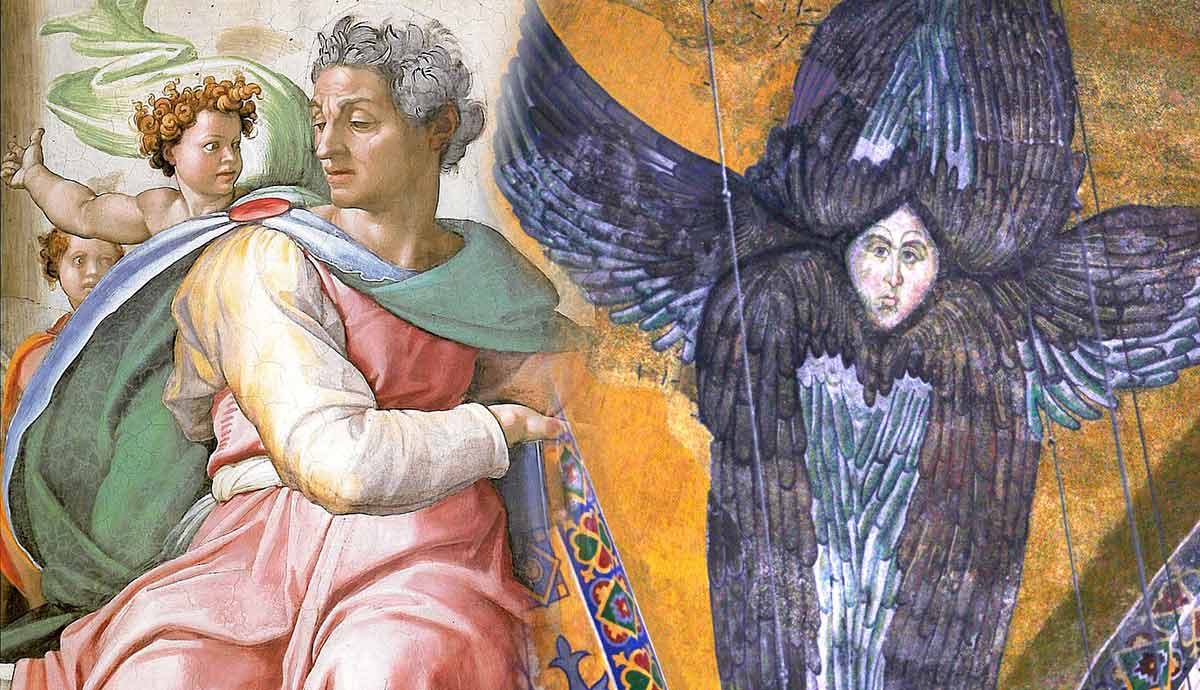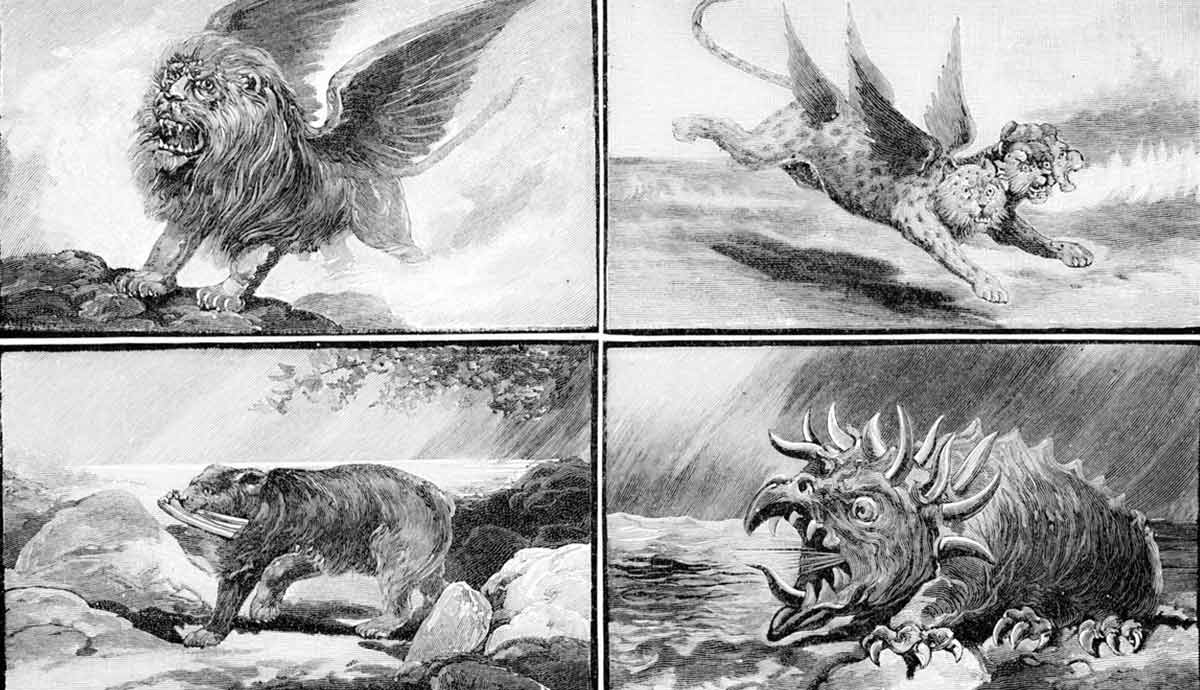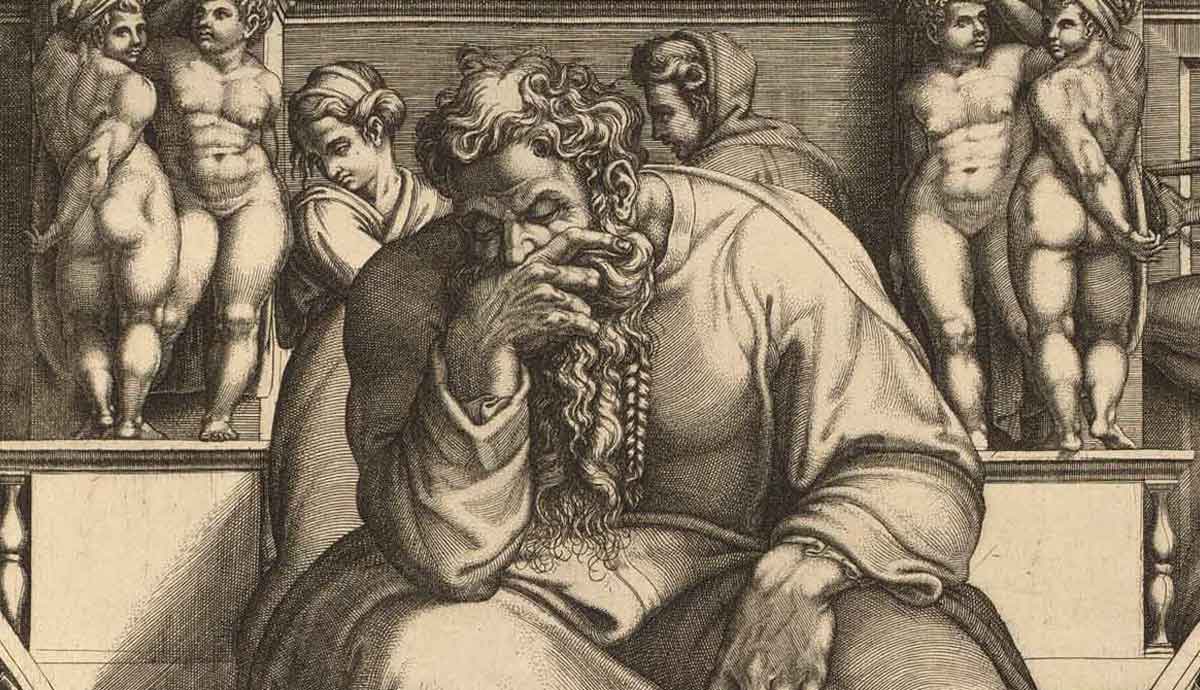
To the casual reader, it would appear that the Seraphim appear in the Biblical scene in Isaiah 6 for the first and only time. No other Bible book refers to these heavenly creatures, or so it may seem. A deeper dive into the original language reveals several references to seraph that contribute to a clearer understanding of the text. Additional comparisons between seraphim and other heavenly entities also suggest that the name may be descriptive rather than a reference to an order of angels that Isaiah alone mentions. So, let’s start with the seraphim in Isaiah and work from there.
The Seraphim in Isaiah

Isaiah mentions the seraphim twice: once in Isaiah 6:2 and again in 6:6. Here is what it says in context:
“In the year that King Uzziah died, I saw the Lord sitting upon a throne, high and lifted up; and the train of his robe filled the temple. Above him stood the seraphim. Each had six wings: with two he covered his face, and with two he covered his feet, and with two he flew. And one called to another and said: ‘Holy, holy, holy is the LORD of hosts; the whole earth is full of his glory!’ And the foundations of the thresholds shook at the voice of him who called, and the house was filled with smoke. And I said: ‘Woe is me! For I am lost; for I am a man of unclean lips, and I dwell in the midst of a people of unclean lips; for my eyes have seen the King, the LORD of hosts!’ Then one of the seraphim flew to me, having in his hand a burning coal that he had taken with tongs from the altar. And he touched my mouth and said: ‘Behold, this has touched your lips; your guilt is taken away, and your sin atoned for.’” (Isaiah 6:1-7)
From this passage, we can glean that seraphim are six-winged heavenly creatures that minister around the throne of God. They cover their feet with one set of wings, their faces with another, and fly with the remaining pair. The text associates the seraphim with the Trisagion (“holy, holy, holy”). One of the seraphim took coal from an altar that was presumably by the throne, touched Isaiah’s lips with it, and informed him that atonement was made for his sins.
The available information is little, but may serve to connect the seraphim with other beings detailed in scripture.
Saraph Elsewhere in Scripture

The word saraph means “burning,” and seraphim is the plural form. It appears twice more in Isaiah, where translators have rendered the word as “fiery” (Isaiah 14:29 and 30:6). It is strongly connected with serpents, even though the Hebrew word for serpent (nâchâsh) does not appear in the text in these two verses. The serpent is implied due to references to seraph in Numbers, as we will see.
Outside of the Book of Isaiah, we find saraph in a similar context. Numbers 21 uses the word saraph twice. In verse six, saraph (fiery) appears next to nâchâsh (snake, serpent, asp), referring to a fiery serpent, though the International Standard Version chose to render the phrase “poisonous serpent.” The verse only uses saraph (fiery), omitting the serpent, though most translations render it “fiery serpent,” believing it implies as much since the next verse mentions that Moses made a serpent of brass. The color of the brass likely depicted the concept of burning. Deuteronomy 8:15 is another instance where saraph appears next to nâchâsh, potentially referring to the events of Numbers 21.
There is no reason to conclude that the fiery serpents from Numbers refer to angelic beings. The context suggests that literal serpents are in view. For that reason, some scholars suggest that the rendering of saraph as “poisonous” is justified. It may even figuratively represent the burning sensation of a poisonous bite by a venomous serpent.
Seraphs, Cherubs, and Living Creatures

Though the word comes from an unknown derivation, Cherubim tend to function as protectors in the presence of God. The Bible mentions them for the first time in Genesis 3:24 when they guarded the entrance to Eden. Ezekiel 28:14 suggests Satan was a cherub, thus one who served next to God’s throne as depicted on the ark of the covenant.
Fire often accompanies the presence of God. When God came down to meet with Moses on Mount Sinai, he descended in fire (Exodus 19:18). Ezekiel 1:26-27 and Daniel 7:9 describe the throne of God and its wheels as fiery. Hebrews 12:29 states, “[O]ur God is a consuming fire.” These descriptions align with seraphim (burning ones) ministering in the presence of God.
Ezekiel 1 and 10 describe the fiery environment around the throne of God. Four living creatures minister there, each having four faces and four wings. “As for the likeness of the living creatures, their appearance was like burning coals of fire, like the appearance of torches moving to and fro among the living creatures. And the fire was bright, and out of the fire went forth lightning. And the living creatures darted to and fro, like the appearance of a flash of lightning.” (Ezekiel 1:13-14) From this description in Ezekiel 1, these creatures conform to the description of “fiery ones,” even though the wing count differs from that of the seraphim.

According to Ezekiel 10:14, the cherubim, who ministered in a fiery environment around God’s throne, had four faces like the living creatures in chapter one. The Ark of the Covenant had two cherubim on the mercy seat. The shekinah glory of God appeared between the outstretched arms of these angelic beings. As a symbol of the heavenly, it indicated that the cherubim ministered in the presence of God, who appeared in fire and lightning.
Revelation also refers to living creatures around God’s throne. There, the creatures are involved in worship, chanting “holy, holy, holy” (the Trisagion). These creatures had six wings like the seraphim. The correlation between the seraphim, the four living creatures, and the cherubim is notable. Equating one with the others is, however, not that simple due to some significant differences.
Make it Make Sense

Ezekiel 10 shows that the four living creatures are cherubim, but there are differences in the descriptions of the four living creatures in Ezekiel and Revelation. The former had four faces each, while the latter had one of the four faces each (Ezekiel 1:10, Revelation 4:7). The faces of the four creatures differ in Ezekiel 1 and 10. Ezekiel 1 lists the face of an ox, while chapter 10 mentions the face of a cherub instead. Contextually, it is unlikely that the four living creatures of Ezekiel 1 and 10 are different. The seraphim had six wings in Isaiah, while the cherubim, identified with the four living creatures, had four. Yet, the four living creatures in Revelation had six wings like the seraphim, and both exclaimed the Trisagion.
The symbolic nature of the referenced passages from Ezekiel, Isaiah, and Revelation may render these technical differences irrelevant. The three sources share one common denominator: they depict heavenly visions. The three authors focused on different aspects of the ministry of beings involved and may have emphasized the features relevant to their respective focus, expressing it in symbolic language.
The four wings of the cherubim, for instance, may better suit the four wheels of the chariot throne, while the six wings of the seraphim and four living creatures before the throne of God are more appropriate in the worship setting where they minister. As such, these descriptions are likely choices of symbolic expression rather than ontological differences.

Similarly, the name seraphim may be a descriptive reference reflecting Isaiah’s focus on their bright appearance. If so, it aligns with the description of four living creatures (cherubim according to Ezekiel) whose “appearance was like burning coals of fire, like the appearance of torches” (Ezekiel 1:13).
The unique correlation that each of the three beings has with the other two, while not sharing any common characteristics among all three, except for their functions of ministering in the presence of God, suggests that identifying them as the same entities described in differing ways is not far-fetched. Ezekiel already establishes that the four living creatures are cherubim, yet the four living creatures and the seraphs have six wings and call the Trisagion in honor of God.
The alternative seems untenable. It implies two sets of living creatures ministering at the throne of God, while each mention of the one set omits mention of the other. Each mention of the cherubim omits mention of the seraphim and vice versa.
Though the Bible does not overtly equate seraphim, cherubim, and the four living creatures with one another, there seems to be enough correlation to conclude that they may be the same beings.










